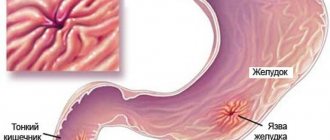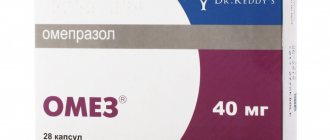High and low acidity
There are two options for stomach acidity disorders: increased and decreased. Both options can provoke unpleasant symptoms and diseases of the digestive tract.
Main manifestations3:
- sour belching;
- pain behind the sternum or in the upper abdomen of a paroxysmal or aching nature.
A persistent increase in the production of hydrochloric acid can lead to the development of acid-related diseases. The most common problem, the manifestations of which are heartburn and sour belching, is gastroesophageal reflux disease2,3. It is characterized by frequent reflux of food from the stomach into the esophagus and chronic weakening of the esophageal sphincter2.
Also, increased acidity can provoke the development of hyperacid gastritis, most often associated with the bacterium Helicobacter Pylori or gastric ulcer3. Only a doctor can make an accurate diagnosis if symptoms of high acidity occur frequently and for a long time after a comprehensive examination.
A decrease in stomach acidity occurs with the development of gastritis with a decrease in the production of hydrochloric acid. With a lack of acid, infectious processes can develop in the digestive tract. In addition, food digestion also worsens due to a lack of enzymes that are activated by hydrochloric acid3.
Manifestations of condition 3:
- increased gas formation;
- heaviness in the stomach;
- bad breath;
- decreased intestinal motility with the risk of constipation.
It is possible to accurately determine the type of stomach acidity only with the help of a special study - intragastric pH-metry3.
Is it possible to cure atrophic gastritis?
Despite the fact that atrophic gastritis can provoke stomach cancer, and the disease can be completely cured only at the initial stage, treatment with modern medicine allows you to minimize unpleasant symptoms and stop the development of the disease, after which it will take some time for the body to recover.
Do not forget that only a doctor can tell you the answer to the question of how to treat atrophic gastritis. Do not take any medications on your own - this can only make the situation worse.
The disease most often develops in middle-aged men and the elderly. In women, atrophic gastritis is not diagnosed very often.
Unfortunately, symptoms and pain are practically absent at the initial stage, so few people suspect the presence of a stomach disease until it becomes impossible to cure it.
People suffering from this disease often complain of a feeling of heaviness in the stomach that accompanies every meal, regardless of its quantity.
The most common complaints are about the following symptoms:
- flatulence;
- constant rumbling in the stomach;
- belching;
- nausea;
- smell from the mouth;
- constipation
The following changes in the body are also often recorded, which, however, can be regarded as signs, and not as mandatory symptoms of gastritis:
- hypovitaminosis (severe decrease in the amount of vitamin B12), which manifests itself in the form of headaches, sticking out of the tongue, anemia and yellowing of the skin;
- hormonal disbalance;
- reduction in body weight.
Causes and diagnosis of the disease
Today, doctors identify 2 main reasons for the appearance and development of the disease:
- Immune causes, when the body, due to an immune failure, regards mucosal cells as foreign and begins to replace them with tissue;
- Bacterial causes, when organs are infected by the bacterium Helicobacter pylori.
Unfortunately, it is not yet possible to say exactly what causes lead to this stomach disease, so treatment is always aimed at these 2 groups.
Also, do not forget about the causes of the disease, which consist in frequent cauterization of the stomach with alcoholic beverages.
The main signs of the disease are obtained through laboratory testing, in particular after the use of gastroscopy and endoscopy.
Diagnosis of atrophic gastritis often involves the use of chromogastroscopy, a method consisting of the process of staining the walls of the stomach and their subsequent examination, as well as measuring the pH level of the stomach, when the level of increased or decreased acidity is determined.
Video:
The most gentle and convenient method of checking for the presence of gastritis of the stomach is a gastropanel - a blood test for the presence of antibodies, certain proteins and hormones.
Together with analysis of the stomach walls, this method will provide the most complete and reliable information about the presence of the disease.
Types of atrophic gastritis
Antral atrophic gastritis affects the antrum of the stomach. The development of the disease, for which there is no timely treatment, leads to deformation and narrowing of the esophagus.
Signs of this type of stomach disease include a high level of gastric juice secretion, dyspeptic digestive disorders, and disruption of the gastrointestinal tract due to achlorhydria. To confirm the diagnosis, gastrofibroscopy is used.
Treatment of antral gastritis of the stomach most often takes place with the use of 2 antibiotics and antisecretory drugs, and sometimes enveloping agents are added.
After getting rid of the pathogenic microflora, the body is restored, also with the use of medications.
Video:
Diffuse atrophic gastritis can be considered an intermediate stage between superficial and dystrophic changes in the walls of the stomach.
This type of gastritis is characterized by the absence of significant dystrophic damage.
Symptoms of a disease such as diffuse atrophic gastritis:
- deepened pits on the mucous membrane;
- disruption of the structure of gland cells;
- formations on the walls of the mucous membrane.
Superficial type – the initial stage of a chronic disease with minimal damage to the mucosa. Treatment at this stage will help completely get rid of the disease.
Superficial gastritis is diagnosed through endoscopy, which is used to determine normal wall thickness, slight hypersecretion of stomach cells and the level of degeneration of the epithelial layer. The superficial appearance of the disease has no clinical symptoms.
Atrophic hyperplastic gastritis is considered one of the most dangerous types of the disease; it is classified as a precancerous condition.
Only after the appearance of polyps does the patient feel the following symptoms:
Gastritis? Ulcer? To prevent a stomach ulcer from turning into cancer, drink a glass...
The best FOLK remedy for GASTRITIS and stomach ulcers!
- flatulence;
- pain in the solar plexus area;
- abdominal pain that may radiate to the lower back;
- a sharp increase in body temperature. If you are diagnosed with “atrophic hyperplastic gastritis” and your temperature suddenly rises, then urgently call an ambulance, as this may be evidence of internal bleeding;
- stool instability.
The main treatment consists of antibiotic therapy. For people with high stomach acidity, the doctor also prescribes antacid medications.
Video:
The acute type of the disease (also called active gastritis) is an exacerbation of inflammation of the stomach walls.
Signs of the disease:
- destruction of the covering layer of the epithelium;
- swelling of the gastric walls;
- vascular congestion;
- entry of leukocytes outside the blood vessels.
Symptoms of acute gastritis:
- nausea and vomiting;
- diarrhea;
- severe pain in the stomach;
- elevated temperature;
- in some cases - fainting.
When the gastric mucosa is exposed to serious pathogens, coma and death are possible.
The chronic type of gastritis (also called inactive) is characterized by prolonged and profound atrophy of gastrointestinal tract cells. The disease develops in people with low acidity.
The pathogenesis often involves the organs of the gastrointestinal tract and endocrine glands. Clinical symptoms are similar to those of gastritis with low acidity.
The mixed type is a combination of several types of gastritis. The main factor in the appearance is considered to be infection with the bacterium Helicobacter pylori.
Mixed gastritis has the following symptoms:
- belching;
- decreased appetite;
- bloating;
- unpleasant taste in the mouth;
- weakness and dizziness.
Treatment begins after determining the types of gastritis that are included in the mixed one.
Basic nutritional recommendations
Treatment of gastritis will not be effective without a special diet. Reviews of its use claim that it not only reduces some symptoms, but also improves the overall immune system in women and men.
If the patient has atrophic gastritis with high acidity, then the diet should contain the following vegetables: cauliflower, potatoes, carrots.
For gastritis with high acidity, the following are prohibited:
- any fermented, pickled, salted, canned products;
- mushrooms in any form;
- cucumbers;
- onion;
- radish;
- Highly acidic greens: spinach and sorrel.
The consumption of crushed zucchini, pumpkin, non-acidic tomatoes, and green peas is allowed only in small quantities.
Soups are useful for any type of gastritis: both with high and low acidity (especially beneficial for low acidity).
Video:
Puree soups made from the “right” products listed above have a very good effect. It is better to cook soup with vegetable broth or milk.
Milk soups with cereals (rice, buckwheat, etc.) or pasta are also welcome. Consumption of cabbage soup, borscht, okroshka, meat, fish or mushroom broth is prohibited for gastritis with low or high acidity.
If you have gastritis with low acidity, it is recommended to eat vegetables and some fruits, boiled cereals, fermented milk products, and not too fatty soups with meat or fish broth.
You can drink juices, coffee and tea, but any alcoholic beverages, smoked and pickled foods, and fast food are strictly prohibited.
It is better to steam the dishes and eat them in small portions. Food should be taken warm; too cold or hot food can cause a decrease in the production of stomach acid.
Atrophic gastritis is an unpleasant disease, which can only be dealt with by following all the doctor’s recommendations, because proper nutrition for atrophic gastritis is the key to success.
Diets for atrophic gastritis
A special diet for atrophic gastritis is an important part of treatment. Depending on the tasks, there are 4 types of food.
For gastritis, diet No. 2 is most often prescribed, which involves nutrition with stimulation of the secretory glands. All dishes should be lightly fried, baked, stewed or boiled.
This diet for atrophic gastritis allows the consumption of meat and fish dishes, dairy products, omelettes, and many types of vegetables.
Reviews about the diet indicate that treatment using it is quite effective.
Diet No. 1 is prescribed for acute pain symptoms in the initial days of the disease and is characterized by the least load on the digestive system.
Reviews prove that when carefully followed, the diet relieves pain after the first days. The purpose of nutrition is to reduce the excitability of the mucous membrane.
This diet is not suitable for people with low acidity, because it is aimed at limiting foods that stimulate mucosal receptors. You can mainly consume pureed soups and dairy products.
Diet for atrophic gastritis No. 3 is used after the acute symptoms of inflammation have subsided. Reviews claim that it does an excellent job of restoring the mucous membrane.
The diet can be used by people with low and high acidity.
Foods rich in fiber, as well as too hot or cold foods, are prohibited. You can eat dairy products, soups, and some vegetables.
In case of acute enteric syndrome with intolerance to milk or other products, diet No. 4 is prescribed.
With this diet, you can normalize the functioning of the stomach by relieving inflammation in the mucous membrane.
Treatment with Diet No. 4 is often prescribed for people with low acidity. You should eat in fractional portions. Reviews confirm the effectiveness of the diet.
Do not forget that the necessary diet should only be prescribed by a doctor, and self-medication can only worsen the stomach disease.
How does Omez® 10 mg affect stomach acidity?
Omez® 10 mg with the active ingredient omeprazole belongs to the group of proton pump inhibitors and is used to treat heartburn and sour belching1. Omez® 10 mg reduces stomach acidity by suppressing the production of hydrochloric acid1. Thus, it directly affects the cause of heartburn, and not just the symptom.
Omez® 10 mg is a convenient drug to use. It is recommended to take it once a day1. The medicine is available in enteric capsules, so the active substance, even with high acidity, will reach the intestines, where absorption into the blood occurs.
Omez® 10 mg for low stomach acidity further reduces acid production. Therefore, for this disorder of the digestive tract, it is better to use other drugs. In particular, with the development of gastritis with low acidity, replacement therapy directly with hydrochloric acid can be used3.
How to take omez for gastritis
Omez is intended for the prevention and treatment of gastritis or stomach ulcers. This remedy helps eliminate the symptoms of the disease, while having minimal side effects.
Most doctors and patients who have undergone treatment recommend it. How to take Omez for gastritis?
This drug belongs to a new group of drugs that can reduce acidity levels.
What is gastritis
Gastritis is an inflammatory process in the stomach area that affects the mucous membrane. For a long time, this disease was not treated and did not attach importance to it.
It was believed that this is a person’s retribution for the fast pace of life. But statistics say that most advanced cases of a disease such as gastritis gradually turn into an oncological compaction.
The main cause of this disease is increased acidity.
But changes in acid levels occur due to autoimmune diseases, untimely nutrition, side effects from medications, and poor quality products.
Also, another reason has recently been identified - the presence of the bacterium Helicobacter pylori.
Why be treated with Omez
There are many options for the effects of drugs on the functioning of the gastrointestinal tract. Should be taken for the following disorders:
- Stomach ulcer. This may occur after taking medications that help if the body needs treatment.
- An inflammatory process that occurs in the lower part of the esophagus.
- For gastritis with increased acidity or atrophic gastritis.
- Inflammation in the pancreas.
- For gastroduodenitis. The instructions indicate how to do this correctly.
Omez for gastritis helps normalize acidity levels. Regardless of what factors caused the disease, a positive effect has been proven.
How to take Omez
Only a qualified specialist can determine the required dosage for a particular person.
If you follow the recommendations, then there is a chance to get the desired result. Omez is prepared in the form of capsules for oral use.
There are a very large number of types of gastritis: atrophic, erosive, with high or low acidity.
The instructions have clear instructions that it is necessary to take the drug depending on the type of disease.
Regardless of the type of disease, the course of rehabilitation therapy lasts quite a long time, but the dosage may depend on the stage of the disease.
For example, in mild cases of the disease, it is recommended to take one tablet every day for several weeks.
Symptoms of inflammation in the stomach are accompanied by diarrhea, heaviness in the abdomen, nausea, and heartburn. They can be eliminated quickly enough with the help of a drug such as omez.
If the bacteria Helicobacter Pylori is present, antibiotics are prescribed; in a particularly advanced stage, 3 antibiotics are prescribed. The instructions have all the answers to such questions.
For gastroduodenitis, you need to take two tablets a day. The tablets must be taken for 30-60 days.
If gastritis occurs along with a stomach ulcer, you must take Omez once a day before bed. At this time it is considered the most effective.
If painful sensations appear in the stomach, then you need to take 2 capsules a day: one in the morning and one in the evening. Treatment lasts for a week.
Afterwards, it is necessary to take one tablet per day for 10 consecutive days for the purpose of prevention.
For chronic gastritis, it is necessary to undergo a course of treatment for up to 4 months. Treatment should be taken 1 capsule per day.
Also, if you have a chronic disease, it is recommended to use drugs every autumn and spring to prevent the occurrence of seasonal exacerbations.
You need to take medications a month before the onset of seasonal reactions. It is necessary to take medications on an individual basis.
The tablet can be consumed whole without chewing. The maximum result can occur only a few hours after taking the drugs.
What can happen with long-term use of Omez
These are drugs of a new era and new time that have a minimum number of contraindications. One of the main ones is considered to be individual intolerance to the ingredients of the drug.
Also, with atrophic gastritis, it is strictly forbidden to take Omez. Since Omeza can lower acidity levels, it is not recommended for use for gastritis with low acidity.
During pregnancy and lactation, only a doctor can prescribe the use of this drug.
Side effect
Despite the minimal side effect, the following symptoms may occur:
- Dizziness, frequent intense headaches.
- Constipation or diarrhea. Irritable bowel syndrome.
- Vomiting and nausea.
- An allergic reaction in the form of skin rashes.
If you have symptoms, you need to take a break and make sure that the cause is the medication you are taking.
In most cases, they may indicate the manifestation of diseases of the gastrointestinal tract.
An overdose of a drug such as Omez may result in the following symptoms: migraine attacks, pain in the stomach area, the oral cavity dries out, body temperature may be lowered, visual acuity decreases, dizziness.
The side effect of the drug goes away on its own as soon as the patient stops using Omez.
Prohibited to accept
The number of contraindications for the use of such a drug as Omez is very limited, but they still exist. The drug should not be taken during pregnancy, regardless of the period.
It is forbidden to take Omez if you have a pituitary adenoma, impaired functioning of the stomach and intestines, as well as bleeding of internal organs of the gastrointestinal tract.
The drug must be taken under the close supervision of a medical specialist.
You should also remind the gastroenterologist if you have taken vitamins, dietary supplements, or medications for the treatment of human viral immunodeficiency syndrome.
How to buy Omez
You can buy it in every pharmacy in the country without a prescription from a doctor. The pricing policy directly depends on the number of tablets or capsules in the package.
Analogues of the drug
If an individual reaction occurs, then it is necessary to change the medicine to a more effective one without side effects.
For example, it could be Omegast, Omegast, Pantap, Ontime, Novobismol, Famotidine.
To avoid adverse reactions, you should consult your doctor about which drug is best and in what dosage it should be taken.
Despite the fact that Omez is considered the safest, it should be taken only under the close supervision of a doctor. He will conduct diagnostics and determine the condition of the internal organs.
This must be done because the symptoms of gastritis may hide such a serious disease as gastric cancer.
Useful video
Omeprazole for gastritis
- 1 The principle of action of Omez for gastritis of the stomach
- 2 Release form and instructions for use
- 3 Contraindications
- 4 Side effects
- 5 Interaction with other drugs
“Omez” (“Omeprazole”) is the best medicine that can control quite dangerous situations associated with stomach diseases. “Omez” for gastritis reduces secretory function, making it independent of irritants that come with food. Regular use of the medicine makes it possible to control the secretion of gastric juice around the clock for comfortable digestion.
The principle of action of Omez for gastritis of the stomach
The active ingredient is pentamethoxybenzimidazole. The instructions for use indicate that Omez has an antiulcer and inhibitory effect, which implies the suppression or inhibition of certain body functions, in our case, the release of hydrochloric acid for digestion. “Omez” for gastritis reduces the activity of the glands, blocks the final stage of the production of gastric juice and pepsin (this is an enzyme that breaks down proteins). By this action, the medicine reduces their number, giving the stomach the opportunity to “rest” while fully performing the digestive function.
This is important for gastritis, when overloading the stomach is unacceptable. "Omeprazole" refers to drugs that act only in an acidic environment, treatment of which must be continued for some time to feel the result. The course is at least a week. It is not intended to provide immediate relief from discomfort or pain.
If gastric contents regularly enter the esophagus during esophagitis, Omez is also prescribed to reduce and normalize acidity. This slows down and prevents further development of the disease and reduces existing symptoms. The medicine improves overall health and reduces the risk of complications. After 2 hours, thanks to the use of the medicine orally, a decrease in secretory function occurs, which lasts for a day. After stopping taking Omez, after 3-4 days, gastric juice begins to be released as usual. Excreted by the kidneys.
Return to contents
Release form and instructions for use
- Capsules, dosage 20 mg of active ingredient.
- Powder for suspension.
- Lyophilisate from which an intravenous solution is prepared and dispensed according to prescription.
Considering that the capsules are intended to dissolve directly in the intestines, they should be taken whole, without chewing, with a few sips of water. Activity does not depend on food intake. If you have difficulty swallowing the capsule whole, its contents can be poured into kefir or yogurt and drunk within half an hour. The minimum course of treatment with Omeprazole for gastritis is 2 weeks. During this period, you should take a capsule (20 mg) every day. During use, the product “calms” and relieves stomach irritation.
Prevention involves taking Omez in the evening, no less than 3 hours before bedtime, to prevent the release of acid.
If you miss a dose, you should not take a double dose. An overdose will cause a number of alarming symptoms:
- visual disturbances;
- headache;
- excitement or vice versa, drowsiness;
- arrhythmia;
- feeling of thirst, feeling of increased sweating.
Ask your doctor how much Omez you need to even out your schedule and continue taking the drug without harm to your health. In case of Helicobacter pylori infection, a double dosage of Omeprazole is prescribed - 40 mg, which corresponds to taking a capsule twice a day in parallel with antibacterial agents. The minimum required course is a week.
Intravenous "Omez" is prescribed when for some reason it is impossible to take the medicine orally. Prevention of acid release into the respiratory tract during anesthesia requires an increased dose of 40 mg.
Return to contents
Contraindications
It is not recommended to take the drug during pregnancy.
Instructions for use do not recommend drinking Omez:
- During pregnancy or breastfeeding. When taking the medicine in the first half of pregnancy, there is a risk of negative effects on the development of the fetus. During lactation, Omez is prescribed when there is a clear need for the mother.
- Children under 5 years old, given the imperfection of the digestive system. If there is a need to prescribe Omez to children, the dose is carefully calculated based on body weight.
- In case of individual intolerance.
- With low acidity, atrophic gastritis.
Return to contents
Side effects
Omeprazole for gastritis is usually well tolerated, but side effects cannot be ruled out. If you stop taking the medication, the negative effects are reversible. Side effects include the following body reactions:
- Stomach upset, dry mouth, changes in taste, stomatitis. Less commonly, liver dysfunction is possible.
- Frequent dizziness, constant sleep disturbances, sometimes hallucinations.
- General weakness.
- Skin itching, the appearance of alopecia (partial baldness).
- Allergies that manifest as hives on the skin, swelling, bronchospasms (difficulty breathing) and anaphylactic shock.
- With long-term use, the formation of a gastric cyst is possible.
- Sometimes there is a feeling of pain in the joints or muscles.
When o or its replacement, these negative consequences go away on their own without consequences.
Return to contents
Interaction with other drugs
Omeprazole changes the bioavailability of the drug, the absorption of which depends on the degree of acidity of the environment. This reduces the absorption of active substances such as ampicillin or ketoconazole. Long-term use of Omez in parallel with caffeine, theophylline, piroxicam or lidocaine does not change the required amount of the substance in the blood plasma. If you drink Omez and Clarithromycin at the same time, the concentration of both active substances in the blood increases.
Taking Omez with Metronidazole or Amoxicillin does not change the presence of substances in the body. The relationship between Omeprazole and antacids (antacids are drugs that neutralize stomach acid, normalizing the gastric environment) has not been noticed.











